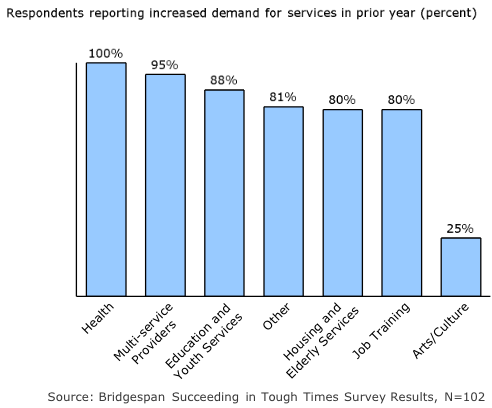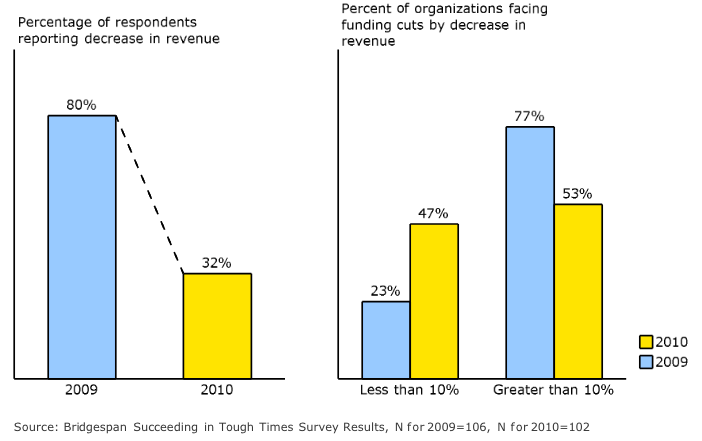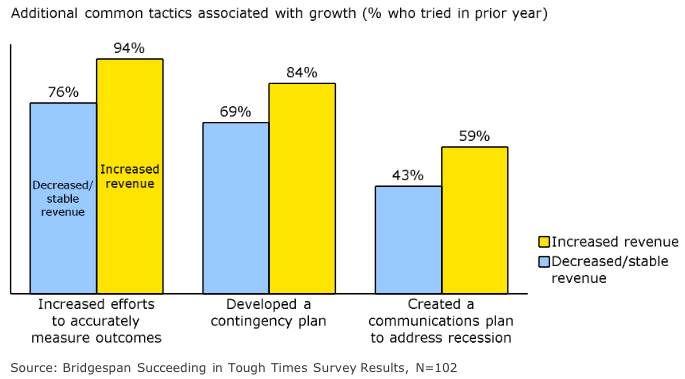Today's nonprofit leader may feel like one of those plate spinners on the old Ed Sullivan Show—adding plate after plate, running ever faster between the poles until it seems a certainty that all will come clattering to the ground. No question about it, the headline from Bridgespan's annual survey of nonprofit leaders is that the great majority of organizations surveyed (84 percent) are experiencing increased demand for their services (compared to 58 percent in the 2009 and 30 percent in the 2008 surveys).
The good news is that the adoption of a set of effective management tactics and an increase in funding for some organizations is helping the sector rise to meet these challenges.
Since the recession began in 2008, Bridgespan has conducted an annual "Managing Through Tough Times" survey of nonprofit leaders to understand how the sector is coping in the downturn. Previous surveys sought to understand both the effects of the recession on the day-to-day work of nonprofits and the tactics organizations were using to stay afloat. This time around, we are exploring not just the tactics being used to navigate tough times, but also which tactics are most associated with growth in revenue. We found a handful that seem to be helping nonprofits not only survive, but also strengthen themselves in the crucible of hard economic times. This year's survey, renamed "Succeeding Through Tough Times," incorporates more than 100 responses from nonprofit leaders received in the fall of 2010 (out of approximately 700 contacted), along with 13 follow-up interviews.
It reveals two trends with significant implications for the sector:
- Nonprofit organizations are experiencing their highest level of demand in years and are coming up with creative solutions to meet this demand.
- We are beginning to see a reduction in the funding cuts that have plagued the sector since the recession began, with a number of organizations able to rebuild revenues despite the downturn.
Results from our survey suggest that the organizations achieving the greatest success followed a common set of management tactics—focusing on collaboration, external communications, contingency planning, and outcome measurement. In this article, we discuss these tactics and provide a roadmap for nonprofit leaders seeking to succeed in the new economic environment.
Increase in Demand for Services
While the country has started on the path to an economic recovery, the world of nonprofits remains very challenging. As seen in almost every recent survey on the state of the sector, there has been a relentless increase in the demand for nonprofit services.1 In our November 2010 survey, 84 percent of organizations reported an increase in demand for their services over the past year, compared with 58 percent in November 2009 and just 30 percent in November 2008. Family service organizations are seeing more low-income families struggling to survive, job training programs have been strained by higher numbers of job seekers, and food pantries face ever-growing lines.
The unfortunate reality for the sector in bad economic times is that an organization's resources are most strained at times when their beneficiaries face the greatest need. Yet, many nonprofits are doing more with less and finding ways to meet those needs. In the past year, 73 percent of direct service nonprofits we surveyed increased the number of people they serve, while 70 percent increased the levels of service provided. How have organizations been able to increase service levels despite the tough economic environment? Time and time again, in survey responses and follow-up interviews, we heard stories of organizations turning to collaborations to meet this increased demand. For our survey respondents, collaborations proved to be one of the most effective tools in maintaining and, in many cases, increasing service levels during the downturn.
Most direct service nonprofits experienced higher demand for services in 2010

Collaborating to Meet Demand
Although many in the nonprofit sector have long promoted collaboration through partnerships and mergers, these have often been difficult to implement. But our survey indicates that while actual mergers are still rare, 61 percent of organizations surveyed said they have developed effective collaborations with other organizations over the past year. One such organization was the Oasis Center in Nashville, TN. The Oasis Center is a $4.2-million organization that helps youth overcome serious challenges such as homelessness, violence, and disconnection that prevent them from transitioning to a healthy adulthood. By sharing space and administrative resources with other organizations providing different services for the same population, the Oasis Center found that it could significantly increase its impact. Director Hal Cato notes that the unemployment rate for low-income youth is now astonishingly high. "So you see more kids dropping out, and more crime and violence as kids try to make ends meet by other means." In order to address this increased need for their services, the Oasis Center has invited other nonprofit organizations that serve youth in the area to share their space rent-free. "We all moved into a building together so that we could be a one-stop shop for youth and share administrative expenses," says Cato. The new space offers a medical clinic, youth employment office, mentoring and tutoring services, and emergency supplies. Cato says of Oasis and its partner organizations, "We share the burden of all the needs that kids walk in the door with, and as a result we have been able to provide more intensive services to more youth."
More Collaboration Success Stories
- The Homeless Prenatal Program serves over 3,600 poor and homeless families in the San Francisco Bay Area every year. Motivated by the knowledge that the first years of life determine a child’s emotional and physical development into adulthood, they’ve successfully partnered with community-based organizations and hospitals to provide pre- and post-natal care, parenting education, and critical support services for families in poverty.
- PHI, a New York-based organization dedicated to advancing home healthcare, provides organizational and curriculum development training support to organizations in over a dozen states. The partnerships help PHI further its mission and gain national recognition, while providing an additional, fee-based revenue stream.
- Rubicon Programs, based in Richmond, CA, provides employment, housing, mental health, legal, and other supportive services to low-income individuals. Rubicon values the participation of partners with unique cultural competencies in its assertive community treatment collaboration, which partners with persons who are chronically homeless and living with mental illness, to begin helping them on their journey of recovery.
Luisa Buada, chief executive officer of Ravenswood Family Health Center in East Palo Alto, CA, discovered that the benefits of collaboration can go far beyond complementary services. Ravenswood is a nonprofit community health center that provides primary medical care and prevention services in southern San Mateo County. The population it serves is geographically and ethnically isolated from the rest of the county, which is among the most prosperous in the nation. When county officials started collecting input for the state's new Mental Health Services Act (Prop 63), Ravenswood joined with other nonprofits in the area to form the East Palo Alto Mental Health Advisory Group. Ms. Buada recalls, "We came together to ensure that the minority and immigrant groups of East Palo Alto were represented in Prop 63." This advisory group has evolved into a network of mental health providers, working together to provide a mental health safety net for the community.
Not only has the coalition provided for the community, but it has also helped its members weather the downturn. "We apply collaboratively for funding. Whenever there is an RFP, we set the criteria for participation and together decide who will apply," explains Buada. "For this to work, we all agreed to share not only the wealth, but also the responsibility that came with each new contract." Working together on Prop 63 helped the coalition build mutual trust. This enabled a deeper level of financial collaboration in which the strength of the coalition helped support its members through the recession.
Leaders must be careful and strategic when choosing their partners. Barrie Hathaway, executive director (ED) of the Stride Center, a nonprofit IT training organization based in Oakland, says that Stride would not be in existence if it were not for its partnerships. The Stride Center works closely with nonprofit training partners in order to deliver its programs and has a number of business partners who provide funding and employment opportunities for their students. In working with both for-profit and nonprofit organizations over the years, Hathaway has learned a lot about what it takes to form a successful collaboration. "First," says Hathaway, "what we bring to the table needs to be central to the other organization's mission and vice versa." This mission centrality helps ensure that both sides remain committed to the collaboration and do not view it as a distraction from their core work. He's seen that non-core programs are often the first to be cut at any sign of financial trouble. Second, taking the time to understand each other's culture and set realistic expectations can help leaders see potential conflicts before they arise. "A lot of conversations have to happen. We have to do our due diligence to understand each other well." Finally and perhaps most importantly, Hathaway believes that in order to sustain a successful collaboration you have to maintain frequent contact with your partners. "Constant touch is so important. We hold weekly meetings with our key partners. When we don't have that contact it's uncomfortable, and that's when things start to fall apart."
Some Signs of Recovery
One bright spot in this year's survey results was an early sign of improved financial conditions for many in the sector. As the economy has stabilized, the rate of organizations experiencing revenue cuts has slowed significantly, while the size of these cuts has also decreased. When we last conducted our survey in 2009, 80 percent of organizations had seen their revenues decrease in the prior year. One year later, the situation appears to be improving, with only 32 percent of organizations reporting revenue cuts. Not only are fewer organizations seeing their revenues cut, but the magnitude of the decrease also seems to be easing. Only 18 percent of those organizations reporting cuts in 2010 saw revenues decline by more than 10 percent versus nearly 62 percent a year ago.
Nonprofits we surveyed saw fewer, less severe funding cuts in 2010

In an encouraging sign, half of nonprofits we surveyed saw their revenue actually increase in 2010. For almost two-thirds of these organizations, revenues increased by 10 percent or more, while almost a third experienced growth of 20 percent or more. However, that growth has been distributed unevenly—smaller organizations have had a harder time increasing their revenue compared to larger ones. Only one-third of nonprofits with less than $1 million in revenue have experienced revenue growth in the past year, while more than half (54 percent) of organizations with revenue greater than $1 million have experienced growth. The smallest nonprofits have had the toughest time, as only 13 percent of nonprofits with less than $500,000 in revenue have experienced growth and almost two-thirds have experienced funding cuts.
Common Tactics Associated with Growth
There is much we can learn from these organizations that continued to thrive despite the challenges. We found that the organizations able to grow in the downturn followed a common set of recommended management tactics at a greater frequency than their peers. In addition to collaboration, these tactics were creating a communications plan to address recession-related issues, conducting contingency planning, and measuring outcomes. While the survey results do not demonstrate that these tactics caused economic growth, they were much more closely associated with organizations in our survey which grew revenues than with those that saw falling revenues.
Certain management tactics were more associated with revenue growth

External communications
Organizations that experienced growth were 36 percent more likely to create a communications plan to address recession-related issues than were their peers. While leaders often focus on internal communications to staff members worried over job security, the example of New York's public radio station, WNYC, reveals the importance of external communications in a recession. For WNYC, communicating how they were managing the recession led to an increase in support from its listeners. CEO Laura Walker recalls, "In October 2008 when the crisis hit, we assured our listeners that we were dedicated to serving them with the kind of relevant information they really needed to weather the downturn, explaining exactly what was happening and providing resources and expertise. It was also important to us to communicate that we are part of the same New York City community as they are, and to assure them that we were thinking about our revenue situation responsibly." The impact of WNYC's consistent messaging to listeners became apparent during their February 2009 Pledge Drive. Although the total amount raised was down from the previous year, the number of listeners pledging increased.
Contingency planning
Organizations that experienced growth have also stepped up efforts to create contingency plans. They were 23 percent more likely to develop a plan than other nonprofits. For Opportunity Village, a Las Vegas nonprofit that serves people with intellectual disabilities, having a contingency plan helped them make necessary adjustments when the economy soured, yet invest for the future when the opportunity presented itself. CEO Ed Guthrie comments, "Our board saw the downturn before most people—I marched in with a budget in 2008, the board looked at it and said, 'you will lose 25 percent of your funding in the next year, now go back and re-write this.' So we were always one step ahead of the downturn." First, Guthrie and his board looked at Opportunity Village's core mission. They then combed through their programs and contracts and assessed them up against this mission. He and his board were able to cut a number of activities that were "nice to haves" but were not core to the organization's mission. Opportunity Village's early planning paid off when some of the anticipated funding cuts failed to materialize. Guthrie recalls, "Later on when our funding didn't drop as much as we anticipated, we were in a strong position to pursue a number of exciting opportunities and expand our services."
Outcome measurement
Organizations that experienced growth were 23 percent more likely to have increased efforts to accurately measure outcomes than those who did not. The Women's Lunch Place serves homeless and low-income women in Boston's Back Bay neighborhood. It recently began a program evaluation initiative, not only as a way to improve its programs, but also to help satisfy demands of funders. Although it is still in the early phases of data collection, the organization hopes that the evaluation program will help it understand which programs are having the most impact on the lives of its guests. The organization is already thinking about how this measurement can help improve its case for funding. Sharon Reilly, ED comments, "We wanted to track outcomes rather than outputs because they are so much more meaningful, especially for foundations and corporate giving programs." She and her staff "understand how much pressure funders are under to spend money wisely, and therefore completely understand their desire to know what they are getting for their dollars." Its story reveals how effective outcomes measurement creates a twofold benefit for organizations in the downturn—bolstering their cases with funders while simultaneously helping them focus on what's truly important for creating impact.
Looking Forward
It remains to be seen whether the improvements in funding we have witnessed in the sector represent a bottoming out of the recession or merely a temporary reprieve from the economic storm. Our survey respondents were guardedly optimistic about the future, with just over half (54 percent) of leaders surveyed anticipating increased revenues in the coming year. But funding uncertainties persist. For one in five organizations whose revenues increased in 2010, the number one concern going into 2011 was the anticipated loss of long-standing government and private funding. These concerns echo those in other surveys of recipients of government stimulus funding. While the future of the economic recovery remains uncertain, what is clear is that implementing a number of carefully thought through management tactics can help make the difference between merely surviving and succeeding in these tough economic times—even with lots of plates in the air.
For more information on the state of the nonprofit sector in the economic downturn, see these recent articles:
"The Effect of the Economy on the Nonprofit Sector," GuideStar, June 2010
"2010 State of the Nonprofit Sector," Nonprofit Finance Fund, March 2010
"Sector Monitor" Report, Imagine Canada, April 2010


